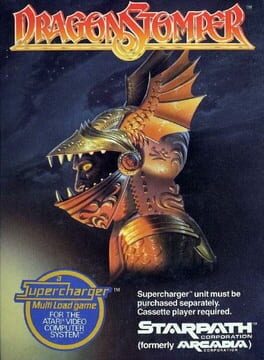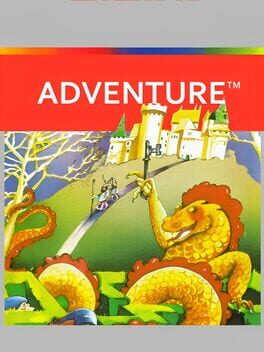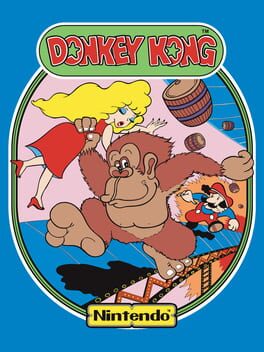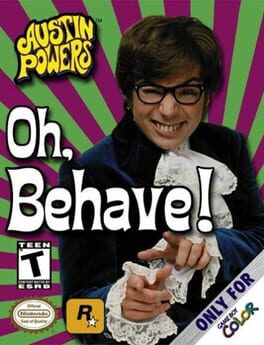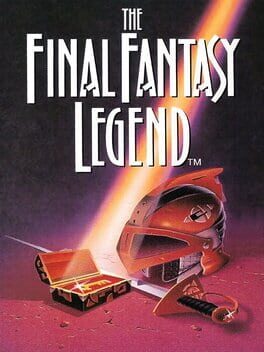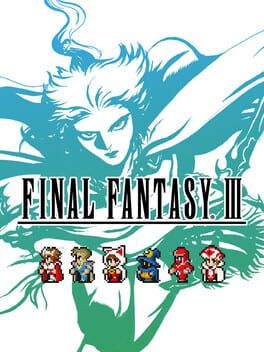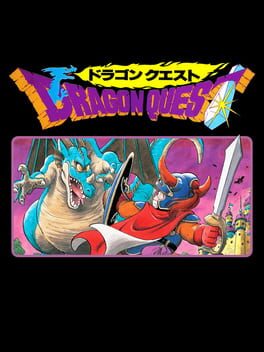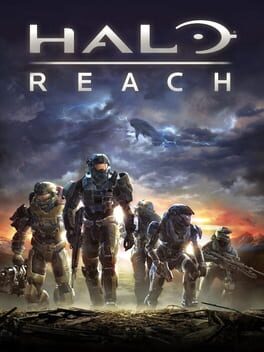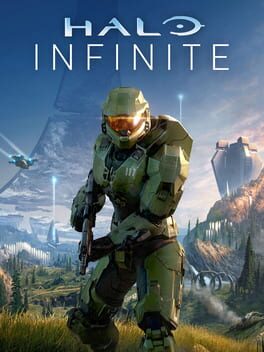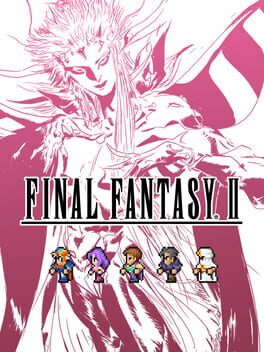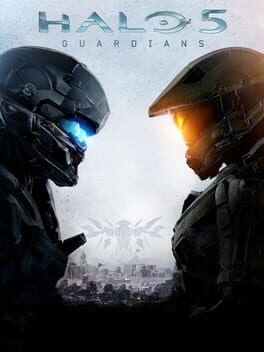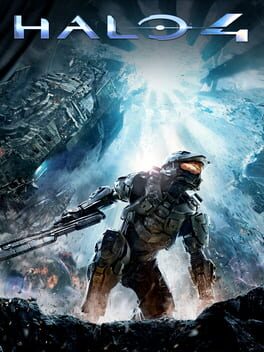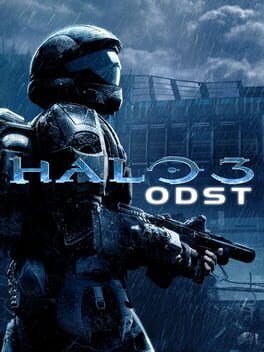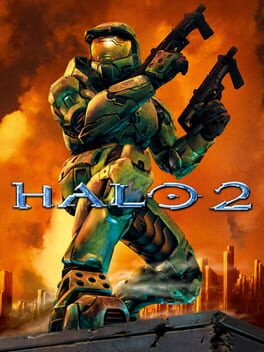ArcaneCrystal
1982
I usually see this spoken of as a historical artifact that was ambitious for its time, but I think Stephen Landrum may have actually delivered a masterpiece that still holds up in 2024. Dragonstomper consolizes the RPG in a unique way that I haven't seen in another game, and in a way that's completely different from Dragon Quest while being no less compelling.
The game is structured into three sequential chapters: exploring the Wilderness, preparing in Town, and assaulting the Dungeon. There's no going back and forth between these modes, once you're done with one it's onto the other. This gives Dragonstomper a tight linear three-act structure that combines really well with its 1-hour length. It's surprisingly modern-feeling, the kind of thing I would expect from an RPG Maker game that has the benefit of 40 years of console RPG history.
The wilderness is a truly desolate place. There are three castles guarded by enormous cursed skulls that will trap you if you walk on them. Animals will guard their habitat jealously if you approach the handful of trees spotting the plain. Combat does not occur on a separate screen, instead enemy sprites will come flying in from a distance, dwarfing the tiny dot that represents your character. You do not gain experience from battle, only money and sometimes items, and half of the items you get will lower your stats. When you approach a hut, its resident is likely to attack you. You can pray at a church, but the game will tell you it has no effect. But you can pay them money to heal you. It's all about the money in this world.
The bridge to town is blocked by a guard who demands to see your ID. You can try to kill him, or you can go loot an ID off the corpse of a "maniac." Or you could bribe the guard with 600 gold, which is no small amount. Once you get into town, called "The Oppressed Village" in the manual, the only people there are merchants and mercenaries. To buy items in a shop you have to physically approach the item sprite, then walk back to the merchant and buy it, at which point the item sprite disappears. This gives the impression that you are buying the last of their stock, that if your assault on the dungeon doesn't work, there's not going to be a second chance. There's no reason not to spend every last gold piece you gathered from the wilderness. You can hire the mercenaries to join you with gold or jewels. No one in town has a single polite word to spare you, only transactions to conduct.
The dungeon is a long corridor filled with trap tiles and poison darts that you have to dodge, wearing you down before the final fight with the dragon. This is a long, grueling battle where your mercenary companions will probably die, and you'll be down to a sliver of health with no items left. It's partially turn based and partially in real-time, because you can try to move around the dragon to claim its prize jewel without killing it, but it'll chase you down if you're not able to stun it with spells. The cycling between your actions, the mercernaries' actions, and the dragon's actions makes this battle feel epic, all with the enormous prize jewel pulsating in the background.
It all adds up to an adventure that feels complete and polished and well-paced, with a tone that reminds me a lot of a Souls game, right down to a boss that you have to strafe around and take potshots at while your allies keep it occupied.
The game is structured into three sequential chapters: exploring the Wilderness, preparing in Town, and assaulting the Dungeon. There's no going back and forth between these modes, once you're done with one it's onto the other. This gives Dragonstomper a tight linear three-act structure that combines really well with its 1-hour length. It's surprisingly modern-feeling, the kind of thing I would expect from an RPG Maker game that has the benefit of 40 years of console RPG history.
The wilderness is a truly desolate place. There are three castles guarded by enormous cursed skulls that will trap you if you walk on them. Animals will guard their habitat jealously if you approach the handful of trees spotting the plain. Combat does not occur on a separate screen, instead enemy sprites will come flying in from a distance, dwarfing the tiny dot that represents your character. You do not gain experience from battle, only money and sometimes items, and half of the items you get will lower your stats. When you approach a hut, its resident is likely to attack you. You can pray at a church, but the game will tell you it has no effect. But you can pay them money to heal you. It's all about the money in this world.
The bridge to town is blocked by a guard who demands to see your ID. You can try to kill him, or you can go loot an ID off the corpse of a "maniac." Or you could bribe the guard with 600 gold, which is no small amount. Once you get into town, called "The Oppressed Village" in the manual, the only people there are merchants and mercenaries. To buy items in a shop you have to physically approach the item sprite, then walk back to the merchant and buy it, at which point the item sprite disappears. This gives the impression that you are buying the last of their stock, that if your assault on the dungeon doesn't work, there's not going to be a second chance. There's no reason not to spend every last gold piece you gathered from the wilderness. You can hire the mercenaries to join you with gold or jewels. No one in town has a single polite word to spare you, only transactions to conduct.
The dungeon is a long corridor filled with trap tiles and poison darts that you have to dodge, wearing you down before the final fight with the dragon. This is a long, grueling battle where your mercenary companions will probably die, and you'll be down to a sliver of health with no items left. It's partially turn based and partially in real-time, because you can try to move around the dragon to claim its prize jewel without killing it, but it'll chase you down if you're not able to stun it with spells. The cycling between your actions, the mercernaries' actions, and the dragon's actions makes this battle feel epic, all with the enormous prize jewel pulsating in the background.
It all adds up to an adventure that feels complete and polished and well-paced, with a tone that reminds me a lot of a Souls game, right down to a boss that you have to strafe around and take potshots at while your allies keep it occupied.
1979
level 1, which is basically a tutorial, is a perfect little distillation of the action-adventure genre. navigate a maze, find a key to open a door, pick up a sword and slay a dragon. but level 2 is just too much man. i'm trying to navigate a maze with limited visibility, which alone is a fine challenge. but i have to keep passing through a flashing room that hurts my eyes while a maddeningly annoying bat keeps stealing my items. i would gladly play variations on level 1, but the variation they made is just no fun at all.
1981
sometimes playing an old game feels like getting the most distilled version of what makes the genre good, but this one is a little tedious to actually play. the jump is a little too unreliable and the obstacles a little too unpredictable in a way that feels tuned to munching quarters. i often found myself just standing still while waiting for an opening, because pushing forward would be too risky. the hammer goes on way too long beyond the point where it served its purpose. it does feel good to learn the game and get better and better at the stages, but i couldn't stop thinking how much i prefer the game boy version of these stages.
the combination of gameboy lean design and kawazu mechanics sandbox makes a strong debut for the first handheld rpg. this is a game that kept me in the "learning how it works" phase almost the whole way through, which is always my favorite part of a game. i even did the whole first world solo because i didn't know how to add party members. that worked out very well for my mutant, who got a lot of big stat boosts early as a reward for her trials.
the limited inventory and weapon durability makes this a game of very careful resource management. there's not much to the combat, even the final boss is beaten just by hitting him hard and fast, but the joy comes from preparing as smartly as you can for the long journey ahead, and using your items judiciously along the way.
the humans are the class that most rewards "preparation", but they're also the most annoying to level up. there's no aesthetic benefit to having to buy their level ups individually and apply them individually, it's just tedious. and since i easily had enough money to max them out by midgame, and since the late game is balanced around them being maxed out, there's no choice but to do the busywork.
mutant is a lot more fun to play, and she was just as good of a warrior as she was a mage. i might run two or even three mutants if i ever replay this. i recommend against trying to micromanage their mutations and just go with the flow. it added a nice spice of randomness to my careful preparations. sometimes the mutations were a welcome boon, sometimes they were a problem that was fun to work around.
the monster adds similarly fun complications, since i didn't look up the transformation mechanics and just tried to feel it out. is it worth it for me to risk eating meat and getting a worse monster? was that last monster strong enough that the transformation might be better? oh, my monster is low on health and durability anyway, maybe i should just go for it... this species kinda sucks anyway, i want to see what a new one is like... all of these were interesting questions to consider. usually the monster was the weakest member of my party, but they would come in clutch just often enough that i appreciated their presence.
i mentioned the tedious human leveling, but there are a couple other annoyances that bring the game down. the text speed is very slow, but for some reason the text speed in cutscenes is way faster. so if i raise the text speed in the menu, cutscenes whiz by way too fast to appreciate what's happening. i couldn't find a comfortable middle ground, but 3 was the closest. the encounter rate is also all over the place. sometimes i would explore a whole floor without a fight, other times i couldn't even get up the stairs without five fights. i don't feel like the overall average encounter rate is excessive, but the way it's distributed doesn't feel great. it's really noticeable during the su-zaku sequence, which initially feels like a fun simulation of a "chase enemy" in the framework of a turn-based rpg, but quickly loses appeal when he attacks you six times in ten steps.
maybe the biggest surprise of this game is how much i loved the setting. a mysterious tower with impossible geography linking together worlds of eclectic genre. every world has mutants, monsters, swords, and guns, but they each have unique framings for these common elements.
overall, a great next step into the kawazu zone. very interesting in playing more saga.
the limited inventory and weapon durability makes this a game of very careful resource management. there's not much to the combat, even the final boss is beaten just by hitting him hard and fast, but the joy comes from preparing as smartly as you can for the long journey ahead, and using your items judiciously along the way.
the humans are the class that most rewards "preparation", but they're also the most annoying to level up. there's no aesthetic benefit to having to buy their level ups individually and apply them individually, it's just tedious. and since i easily had enough money to max them out by midgame, and since the late game is balanced around them being maxed out, there's no choice but to do the busywork.
mutant is a lot more fun to play, and she was just as good of a warrior as she was a mage. i might run two or even three mutants if i ever replay this. i recommend against trying to micromanage their mutations and just go with the flow. it added a nice spice of randomness to my careful preparations. sometimes the mutations were a welcome boon, sometimes they were a problem that was fun to work around.
the monster adds similarly fun complications, since i didn't look up the transformation mechanics and just tried to feel it out. is it worth it for me to risk eating meat and getting a worse monster? was that last monster strong enough that the transformation might be better? oh, my monster is low on health and durability anyway, maybe i should just go for it... this species kinda sucks anyway, i want to see what a new one is like... all of these were interesting questions to consider. usually the monster was the weakest member of my party, but they would come in clutch just often enough that i appreciated their presence.
i mentioned the tedious human leveling, but there are a couple other annoyances that bring the game down. the text speed is very slow, but for some reason the text speed in cutscenes is way faster. so if i raise the text speed in the menu, cutscenes whiz by way too fast to appreciate what's happening. i couldn't find a comfortable middle ground, but 3 was the closest. the encounter rate is also all over the place. sometimes i would explore a whole floor without a fight, other times i couldn't even get up the stairs without five fights. i don't feel like the overall average encounter rate is excessive, but the way it's distributed doesn't feel great. it's really noticeable during the su-zaku sequence, which initially feels like a fun simulation of a "chase enemy" in the framework of a turn-based rpg, but quickly loses appeal when he attacks you six times in ten steps.
maybe the biggest surprise of this game is how much i loved the setting. a mysterious tower with impossible geography linking together worlds of eclectic genre. every world has mutants, monsters, swords, and guns, but they each have unique framings for these common elements.
overall, a great next step into the kawazu zone. very interesting in playing more saga.
2021
this is the most that i have felt like i am playing a prototype of real final fantasy, rather than a fully formed game. there's a lot to like about this! it has an astounding sense of scale that almost feels "next-gen" despite still being a famicom game. it's really cool to see the edge of the world or the gnome forest or the endless sea or the enormous saronia or the interior of the invincible. especially in the mid-game, there are lots of fun job combinations. the focus on hidden paths and items gives a nice sense of exploration.
but even though this game has lots of interesting pieces, they're all a little clunkily assembled. this goes for a dragon quest 3 style episodic town structure, but the episodes resolve themselves so quickly that it barely feels like anything happened. there are a few good ones like the town of cursed outlines or the floating forest in the desert or goldmember's mansion, but overall i could tell you more about the towns in ff1 than i could the towns of ff3. the lack of character in town episodes is especially noticeable in saronia, a huge city where npcs all say the same things.
there are lots of little annoyances in traversal that add up. it's fun to have a shrinking sequence where you're forced to use magic once or twice, but tedious to have to shrink or frogify just to get through a gate and reverse your status. hopping mountains with the invincible feels slow every time. and having to park one airship to go ride the other airship that can dive underwater is always a chore. despite the hidden paths in towns and dungeons, the dungeon layouts tend to be very boring. lots of simple hallways and symmetrical rooms that don't give much sense of exploration beyond noticing a hidden path. this really contributes to the final gauntlet feeling like a slog, just as much as the difficulty spike.
crystals handing out sets of jobs gives the game unique "mechanical chapters", where you'll use one set before moving on to the next set. the early jobs feel a little restrictive because it takes a while before you get the good spells, but mid-game jobs like geomancer, viking, bard, ranger, and thief have interesting unique abilities. i did like the boss fights that were built around short-term gimmick jobs like scholar and dragoon, but i wish those sequences had more than one design trick each. the late-game jobs settle into the good versions of the base jobs, which is fine but does feel like the game giving up on the potential of the job system before it really had a chance to blossom. but it is a fun consequence of the gendered job designs that the warriors of light come off as genderfluid. i think ff2's equipment system ultimately does a better job of making characters feel adaptable to different situations, even without unique commands.
all that said, i'm still mostly positive about this game. i got to see some nice sights and listen to some nice music and build some nice teams. they can't all be as revelatory as ff2.
but even though this game has lots of interesting pieces, they're all a little clunkily assembled. this goes for a dragon quest 3 style episodic town structure, but the episodes resolve themselves so quickly that it barely feels like anything happened. there are a few good ones like the town of cursed outlines or the floating forest in the desert or goldmember's mansion, but overall i could tell you more about the towns in ff1 than i could the towns of ff3. the lack of character in town episodes is especially noticeable in saronia, a huge city where npcs all say the same things.
there are lots of little annoyances in traversal that add up. it's fun to have a shrinking sequence where you're forced to use magic once or twice, but tedious to have to shrink or frogify just to get through a gate and reverse your status. hopping mountains with the invincible feels slow every time. and having to park one airship to go ride the other airship that can dive underwater is always a chore. despite the hidden paths in towns and dungeons, the dungeon layouts tend to be very boring. lots of simple hallways and symmetrical rooms that don't give much sense of exploration beyond noticing a hidden path. this really contributes to the final gauntlet feeling like a slog, just as much as the difficulty spike.
crystals handing out sets of jobs gives the game unique "mechanical chapters", where you'll use one set before moving on to the next set. the early jobs feel a little restrictive because it takes a while before you get the good spells, but mid-game jobs like geomancer, viking, bard, ranger, and thief have interesting unique abilities. i did like the boss fights that were built around short-term gimmick jobs like scholar and dragoon, but i wish those sequences had more than one design trick each. the late-game jobs settle into the good versions of the base jobs, which is fine but does feel like the game giving up on the potential of the job system before it really had a chance to blossom. but it is a fun consequence of the gendered job designs that the warriors of light come off as genderfluid. i think ff2's equipment system ultimately does a better job of making characters feel adaptable to different situations, even without unique commands.
all that said, i'm still mostly positive about this game. i got to see some nice sights and listen to some nice music and build some nice teams. they can't all be as revelatory as ff2.
1993
the pc rpg made beautiful and approachable. akira toriyama, one of the greatest to ever do it, delivers monsters that love being monsters and are psyched to fight the hero. this is no threatening dungeon crawler, but a fun fantasy manga that kids can play. perfectly structured and paced, and easy to see why it became an instant classic.
2001
it's funny how different this world feels from any of the sequels. the covenant treat halo as a weapon and seem to have a vague warrior-religion rather than forerunner worship or a great journey, halo doesn't kill flood, chief is a mark v cyborg, cortana is primarily a ship ai, sergeant johnson is not even really a specific character but just another class of marine that spawns alongside you on missions.
it can't be overstated how awesome the pistol feels to use, and it's a wonder that they never brought it back in campaign. halo is really pretty and the music is excellent. despite that, i found myself kinda down on the first half of this game. interesting level layouts are mixed in with repetitive corridors, and there's not much of a narrative drive to the action. any sense of mystery to halo is smothered by the focus on military objectives, and even that doesn't land because i don't know what the stakes of the war are. i certainly couldn't tell you that the covenant are genocidal or that humanity is badly losing. also the tank controls suck.
but the second half of this game is way stronger. the unrelenting aggression of the flood forced me to keep moving and manage my distance carefully, and there's a much stronger sense of urgency to the narrative. the library is a standout level because it's a pure combat gauntlet: keep moving forward against an enemy that keeps pushing you back. plus you get to use the shotgun.
it successfully communicates the overwhelming nature of a flood outbreak, and makes the reveal of halo's function easy to understand. what else could you do against a galactic flood outbreak? the marines previously held their own against the covenant, but are utterly outmatched against the flood. they spread so fast in just a few levels, and the three-way fights between you and covenant struggling to survive against flood makes the retread of previous levels feel exciting. it's no longer a somewhat aimless conflict on the ring, but a race against the dual villains of the flood and guilty spark.
it can't be overstated how awesome the pistol feels to use, and it's a wonder that they never brought it back in campaign. halo is really pretty and the music is excellent. despite that, i found myself kinda down on the first half of this game. interesting level layouts are mixed in with repetitive corridors, and there's not much of a narrative drive to the action. any sense of mystery to halo is smothered by the focus on military objectives, and even that doesn't land because i don't know what the stakes of the war are. i certainly couldn't tell you that the covenant are genocidal or that humanity is badly losing. also the tank controls suck.
but the second half of this game is way stronger. the unrelenting aggression of the flood forced me to keep moving and manage my distance carefully, and there's a much stronger sense of urgency to the narrative. the library is a standout level because it's a pure combat gauntlet: keep moving forward against an enemy that keeps pushing you back. plus you get to use the shotgun.
it successfully communicates the overwhelming nature of a flood outbreak, and makes the reveal of halo's function easy to understand. what else could you do against a galactic flood outbreak? the marines previously held their own against the covenant, but are utterly outmatched against the flood. they spread so fast in just a few levels, and the three-way fights between you and covenant struggling to survive against flood makes the retread of previous levels feel exciting. it's no longer a somewhat aimless conflict on the ring, but a race against the dual villains of the flood and guilty spark.
2010
it's funny how much this is responding to call of duty dethroning halo in the late 00s. desaturated color, increased focus on the human military, sections where you just walk forward while your buddies speak jargon, helicopter rides, turret sections, a guided sniper rifle section, even emile's helmet evokes ghost from modern warfare 2.
even though the human military aspects of halo are by far the least interesting parts to me, i think this game sells the scenario well. small victories get overshadowed by increasingly devastating losses, noble sacrifices give way to unceremonious deaths, the possibility of winning is replaced with a desperate attempt to lose less badly. odst is a similar scenario of you as the newest member of a squad on a battlefield you can't win, but i prefer the straightforward tragedy of this to odst firefly quipping.
the levels are varied and mix up the encounters frequently. painting targets for airstrikes, jetpacking through the city, flying from building to building while you see ships glassing the planet in the distance, a mongoose run through a squad of scarabs. the way that enemies appear in huge swarms sells that the covenant have committed everything to the biggest battle of the war, and are prepared to take heavy losses too. even though a lot of these levels serve a dual function as firefight or pvp maps, they never feel too "firefighty" like some parts of odst and especially halo 4. there's always an interesting layout and a good narrative context for what you're doing. the only major dud is the space dogfight section, which goes on way too long for how rudimentary it is.
even though the human military aspects of halo are by far the least interesting parts to me, i think this game sells the scenario well. small victories get overshadowed by increasingly devastating losses, noble sacrifices give way to unceremonious deaths, the possibility of winning is replaced with a desperate attempt to lose less badly. odst is a similar scenario of you as the newest member of a squad on a battlefield you can't win, but i prefer the straightforward tragedy of this to odst firefly quipping.
the levels are varied and mix up the encounters frequently. painting targets for airstrikes, jetpacking through the city, flying from building to building while you see ships glassing the planet in the distance, a mongoose run through a squad of scarabs. the way that enemies appear in huge swarms sells that the covenant have committed everything to the biggest battle of the war, and are prepared to take heavy losses too. even though a lot of these levels serve a dual function as firefight or pvp maps, they never feel too "firefighty" like some parts of odst and especially halo 4. there's always an interesting layout and a good narrative context for what you're doing. the only major dud is the space dogfight section, which goes on way too long for how rudimentary it is.
2021
deeply tragic game. they finally nailed the fundamentals! weapons sound good and all have distinct useful niches. enemies are easy to identify and read at a distance, and their ai is varied and challenging. the grappling hook is a great addition, and it's fun to throw barrels at enemies.
unfortunately, this game is severely lacking in level design. it's mostly indistinguishable banished bases in the forest and monotonous forerunner hallways. lots of annoying boss fights. the only trick to mix up fights is bringing in more reinforcements. every objective is actually three instances of the same objective. and in case you felt like the game wasn't padded enough, you'll have to fetch power seeds to open doors. this game is a great example of how good mechanics isn't actually enough to make a good campaign.
it's especially frustrating because it's the exact opposite of halo 5, a game that had great level design but weak guns and poor ai. if they applied infinite's mechanics to halo 5's levels instead of the sloppiest of open world slop, it would be a great game!
and as the fundamentals have gotten better, the story has only gotten worse and worse. the conflict set up in the last game is resolved offscreen. a guy named atriox kills everyone from the last two games and then also dies offscreen, only to be replaced with a guy who basically has the same demeanor but is different because his name is escharum. he loves to give long speeches but none of it lands because he never actually does anything. esparza just wants to go home but eventually learns to worship the chief. the conflict with weapon is suddenly dropped without actually being resolved. a third ancient evil awakens but that's a tertiary plotline. chief's ex-wife apologizes to him for being such a bitch and gives her blessing to his new younger girlfriend. embarrassing stuff.
unfortunately, this game is severely lacking in level design. it's mostly indistinguishable banished bases in the forest and monotonous forerunner hallways. lots of annoying boss fights. the only trick to mix up fights is bringing in more reinforcements. every objective is actually three instances of the same objective. and in case you felt like the game wasn't padded enough, you'll have to fetch power seeds to open doors. this game is a great example of how good mechanics isn't actually enough to make a good campaign.
it's especially frustrating because it's the exact opposite of halo 5, a game that had great level design but weak guns and poor ai. if they applied infinite's mechanics to halo 5's levels instead of the sloppiest of open world slop, it would be a great game!
and as the fundamentals have gotten better, the story has only gotten worse and worse. the conflict set up in the last game is resolved offscreen. a guy named atriox kills everyone from the last two games and then also dies offscreen, only to be replaced with a guy who basically has the same demeanor but is different because his name is escharum. he loves to give long speeches but none of it lands because he never actually does anything. esparza just wants to go home but eventually learns to worship the chief. the conflict with weapon is suddenly dropped without actually being resolved. a third ancient evil awakens but that's a tertiary plotline. chief's ex-wife apologizes to him for being such a bitch and gives her blessing to his new younger girlfriend. embarrassing stuff.
2021
the beauty of this system is that you benefit from everything that happens. there's no such thing as a wasted spell or a battle that drained more resources than it was worth. if you get hit it benefits you, if you miss it benefits you, if you have a long drag-out battle it benefits you more than an easy battle. perfectly tuned with 0.5x everything and hp compensation off. i recommend resisting the impulse to try to optimize the game and just play it however you want, because the system will conform to your playstyle like memory foam.
the emperor is one of the coolest villains in the series. the guest character structure lets you see the possibilities of what your permanent party members could become. equipment must be chosen carefully to balance all the different stats it affects. it's easy to change anyone's build midgame, as a precursor to the formalized job system. the enemy rank system means it doesn't take long for new skills to catch up, the loot encourages weapon switching by giving you powerful weapons of types you haven't used yet, and taking advantage of elemental weaknesses makes even low-level spells powerful in the right circumstances.
just a really smart evolution of the jrpg, and a game that makes me excited to check out saga.
the emperor is one of the coolest villains in the series. the guest character structure lets you see the possibilities of what your permanent party members could become. equipment must be chosen carefully to balance all the different stats it affects. it's easy to change anyone's build midgame, as a precursor to the formalized job system. the enemy rank system means it doesn't take long for new skills to catch up, the loot encourages weapon switching by giving you powerful weapons of types you haven't used yet, and taking advantage of elemental weaknesses makes even low-level spells powerful in the right circumstances.
just a really smart evolution of the jrpg, and a game that makes me excited to check out saga.
2015
this is a real two steps forward one step back situation. let's start with the good.
the new spartan abilities are cool! this is a nice example of the mid-2010s "mobility shooter" trend, where you can now dash, slide, clamber, and hover for free. it's fun to do a sprinting melee or a dive bomb on enemies.
although readability is still an issue in this game, something even the game concedes by highlighting items for you, it's not as bad as halo 4. in fact, the environments are genuinely beautiful! some of the best images in the series are here. the level design is unique for the series, every room is very open and offers lots of different paths for flanking and finding weapon caches to give to yourself and your allies. you're always moving forward, and each room is different from the last. there are even a few cool setpieces with the guardians.
however, the quality level layouts are betrayed by the completely undemanding enemy ai, which was previously one of halo's most distinctive characteristics. very rarely was i actually forced to move positions or change strategies. half the time they were so distracted by my squad that they didn't even attack me at all. i tried turning up the difficulty but it didn't affect ai routines, just changed the damage numbers to make encounters take longer. these beautiful, cleverly designed levels just become scenery for a pretty mindless shooting gallery. which might be fine, if most of the guns didn't sound so weak, or of half of them weren't just slight variations on each other. even the vehicle sections are strangely scarce of enemy vehicles to shoot.
these eight main characters actually have a lot of dialogue, and yet somehow still only have half a personality between them. the dialogue is 90% dry exposition and 10% lame quips, all delivered in the tone of someone reading off a powerpoint slide. there are three non-combat missions where you just listen to people talk in a room, and there are audio logs strewn throughout the levels, and somehow none of it is memorable! even the arbiter doesn't get a single cool line.
the meridian arc of the story has a little bit of interesting mystery and tension with governer sloan, and completing optional objectives to protect the colony is a fun dash of roleplaying. but the rest of the story is bizarrely dramatically inert. most of the important events seem to happen offscreen. a third of the game is spent on sanghelios, which is presented as some kind of endless quagmire, but the situation is no more politically complex than arbiter vs covenant, and the covenant are already fragmented and leaderless before you get there, making the arbiter's victory feel like a foregone conclusion. he has no villain to strive against, no loyalties to manage, nothing resembling a dramatic scenario. and the spartans don't even really care about the conflict, they do five levels just to hitch a ride on a guardian.
in only three levels, chief's story repeats the same beats over and over. it's just a road to cortana with the warden eternal telling you to fuck off over and over. the big confrontation should theoretically be interesting, but everyone is already perfectly certain of their position and course of action from the beginning, so there's not much drama to explore. you know how exactly how that confrontation is going to go five hours before you get there. the game keeps bringing up the struggles of ai, but always chooses to cut away from the scene before anyone can have a real conversation about it.
the new spartan abilities are cool! this is a nice example of the mid-2010s "mobility shooter" trend, where you can now dash, slide, clamber, and hover for free. it's fun to do a sprinting melee or a dive bomb on enemies.
although readability is still an issue in this game, something even the game concedes by highlighting items for you, it's not as bad as halo 4. in fact, the environments are genuinely beautiful! some of the best images in the series are here. the level design is unique for the series, every room is very open and offers lots of different paths for flanking and finding weapon caches to give to yourself and your allies. you're always moving forward, and each room is different from the last. there are even a few cool setpieces with the guardians.
however, the quality level layouts are betrayed by the completely undemanding enemy ai, which was previously one of halo's most distinctive characteristics. very rarely was i actually forced to move positions or change strategies. half the time they were so distracted by my squad that they didn't even attack me at all. i tried turning up the difficulty but it didn't affect ai routines, just changed the damage numbers to make encounters take longer. these beautiful, cleverly designed levels just become scenery for a pretty mindless shooting gallery. which might be fine, if most of the guns didn't sound so weak, or of half of them weren't just slight variations on each other. even the vehicle sections are strangely scarce of enemy vehicles to shoot.
these eight main characters actually have a lot of dialogue, and yet somehow still only have half a personality between them. the dialogue is 90% dry exposition and 10% lame quips, all delivered in the tone of someone reading off a powerpoint slide. there are three non-combat missions where you just listen to people talk in a room, and there are audio logs strewn throughout the levels, and somehow none of it is memorable! even the arbiter doesn't get a single cool line.
the meridian arc of the story has a little bit of interesting mystery and tension with governer sloan, and completing optional objectives to protect the colony is a fun dash of roleplaying. but the rest of the story is bizarrely dramatically inert. most of the important events seem to happen offscreen. a third of the game is spent on sanghelios, which is presented as some kind of endless quagmire, but the situation is no more politically complex than arbiter vs covenant, and the covenant are already fragmented and leaderless before you get there, making the arbiter's victory feel like a foregone conclusion. he has no villain to strive against, no loyalties to manage, nothing resembling a dramatic scenario. and the spartans don't even really care about the conflict, they do five levels just to hitch a ride on a guardian.
in only three levels, chief's story repeats the same beats over and over. it's just a road to cortana with the warden eternal telling you to fuck off over and over. the big confrontation should theoretically be interesting, but everyone is already perfectly certain of their position and course of action from the beginning, so there's not much drama to explore. you know how exactly how that confrontation is going to go five hours before you get there. the game keeps bringing up the struggles of ai, but always chooses to cut away from the scene before anyone can have a real conversation about it.
2012
the two levels that i think are mostly well done are "reclaimer" and "composer". reclaimer is the only level that gives the vehicles some room to maneuver, and it's fun to ride the mammoth, paint targets, and destroy a covenant ship from the inside. composer is just good meat-and-potatoes halo combat, where you're never in one room too long, and each room has a meaningfully different layout from the last.
the rest of the game is a lot of very similar-feeling symmetrical combat arenas with battles that drag on for way too long, connected by similar-feeling corridors with enemy placement so apparently thoughtless that it feels more like a long firefight session than a campaign. occasionally these will be interrupted by an awkward flying sequence or a very 2012core "run forward while things explode around you" setpiece, which never feel half as cool as the warthog runs or scarab fights of previous games.
all of the sound in this game is weirdly compressed, making covenant barks sound robotic and guns weak and piddly. the storm rifle in particular might be one of the most unpleasant guns i've ever used in a shooter. also half the cutscenes had audio bugs where voices or effects or music just didn't play.
the only positive thing i can say for the visual design is that the skyboxes are pretty nice. reclaimer and composer also stand out for having an environment that is nice to look at without being too distracting. but the forerunner designs are so needlessly greebly that they're just exhausting to look at. there's so much visual information to process that doesn't really communicate anything about the space, because it's all still just a metal room. i couldn't tell you the difference between one room on requiem and another. this visual noise often gets in the way of actually identifying targets and items, especially when fighting prometheans in a forerunner environment.
the updates to the covenant and human designs similarly consist of splitting everything up into smaller segments and adding a million bits and bobs on top. i guess it is technically impressive how many polygons and how much texture resolution is spent on it, but it just doesn't look very good! halo 2's new mombasa is blocky and half the buildings look like they didn't finish texturing them, but it still has more variety and character than most of the levels in this game. and you can easily identify enemies and items at a distance, too.
the only positive thing i can say for the story is that jen taylor delivers a good performance as rampant cortana. the rest is a baffling mishmash of ideas that seem to suggest themes but never quite cohere into anything. instead of forerunners being humans, it turns out the covenant were right and they are gods with the power to implant genetic destinies thousands of years into the future. zeus believes that only the olympians should rule, but juno is a patron of humanity to such a fanatical degree that she will make excuses for all their mistakes and doom mt olympus to ensure their ascendancy. she is good eugenics mom and halsey is bad eugenics mom, but also halsey is kind of like zeus because she turns humans into machines. is master chief ever really machine-like in behavior? should i care that spartan-4s are replacing spartan-2s? there's a captain who is constantly condescending and makes bad decisions for no reason and yells petulantly whenever he doesn't get his way, just in case you might accidentally find him sympathetic. the cutscene direction is bland and dialogue scenes in particular are shot like a recording of a stage play. cj cowan's visual storytelling is sorely missed.
the rest of the game is a lot of very similar-feeling symmetrical combat arenas with battles that drag on for way too long, connected by similar-feeling corridors with enemy placement so apparently thoughtless that it feels more like a long firefight session than a campaign. occasionally these will be interrupted by an awkward flying sequence or a very 2012core "run forward while things explode around you" setpiece, which never feel half as cool as the warthog runs or scarab fights of previous games.
all of the sound in this game is weirdly compressed, making covenant barks sound robotic and guns weak and piddly. the storm rifle in particular might be one of the most unpleasant guns i've ever used in a shooter. also half the cutscenes had audio bugs where voices or effects or music just didn't play.
the only positive thing i can say for the visual design is that the skyboxes are pretty nice. reclaimer and composer also stand out for having an environment that is nice to look at without being too distracting. but the forerunner designs are so needlessly greebly that they're just exhausting to look at. there's so much visual information to process that doesn't really communicate anything about the space, because it's all still just a metal room. i couldn't tell you the difference between one room on requiem and another. this visual noise often gets in the way of actually identifying targets and items, especially when fighting prometheans in a forerunner environment.
the updates to the covenant and human designs similarly consist of splitting everything up into smaller segments and adding a million bits and bobs on top. i guess it is technically impressive how many polygons and how much texture resolution is spent on it, but it just doesn't look very good! halo 2's new mombasa is blocky and half the buildings look like they didn't finish texturing them, but it still has more variety and character than most of the levels in this game. and you can easily identify enemies and items at a distance, too.
the only positive thing i can say for the story is that jen taylor delivers a good performance as rampant cortana. the rest is a baffling mishmash of ideas that seem to suggest themes but never quite cohere into anything. instead of forerunners being humans, it turns out the covenant were right and they are gods with the power to implant genetic destinies thousands of years into the future. zeus believes that only the olympians should rule, but juno is a patron of humanity to such a fanatical degree that she will make excuses for all their mistakes and doom mt olympus to ensure their ascendancy. she is good eugenics mom and halsey is bad eugenics mom, but also halsey is kind of like zeus because she turns humans into machines. is master chief ever really machine-like in behavior? should i care that spartan-4s are replacing spartan-2s? there's a captain who is constantly condescending and makes bad decisions for no reason and yells petulantly whenever he doesn't get his way, just in case you might accidentally find him sympathetic. the cutscene direction is bland and dialogue scenes in particular are shot like a recording of a stage play. cj cowan's visual storytelling is sorely missed.
2009
as an expansion to halo 3 this is still basically fun to play, and going back to single-wielding makes the weapon set feel more balanced. generally i think the encounter design is good, but what this game really struggles with is scenario.
mombasa streets is a neat idea but ultimately the weakest part of the game. the districts are so indistinguishable that they had to put big numbers on the wall to identify them, and the city is so heavily gated that there's little sense of exploration. i feel like i have less of a sense of the character of this city than i got from the two levels in halo 2. sure, the music is very good, but seeing the same streets and corridors again and again gets old fast. it's a real pacing killer between the main levels.
the main levels are also a mixed bag aesthetically, though the second half is stronger. there's a lot of the same old streets and a dull yellow haze over everything. the frame story sets up these missions as clues to some kind of mystery, but half of them are just fighting towards an objective that isn't especially clear or important. characters will even joke that they're not sure why they're doing this!
and the biggest problem of all is indeed the characters. they are deeply obnoxious to me, constantly making unfunny quips or engaged in a baffling exes arguing subplot. the central mystery goes nowhere until the plot suddenly all happens at once in the last two levels, and after all the build-up it just amounts to rescuing an information source that tells them the premise of halo 3. but the superintendent is cute.
mombasa streets is a neat idea but ultimately the weakest part of the game. the districts are so indistinguishable that they had to put big numbers on the wall to identify them, and the city is so heavily gated that there's little sense of exploration. i feel like i have less of a sense of the character of this city than i got from the two levels in halo 2. sure, the music is very good, but seeing the same streets and corridors again and again gets old fast. it's a real pacing killer between the main levels.
the main levels are also a mixed bag aesthetically, though the second half is stronger. there's a lot of the same old streets and a dull yellow haze over everything. the frame story sets up these missions as clues to some kind of mystery, but half of them are just fighting towards an objective that isn't especially clear or important. characters will even joke that they're not sure why they're doing this!
and the biggest problem of all is indeed the characters. they are deeply obnoxious to me, constantly making unfunny quips or engaged in a baffling exes arguing subplot. the central mystery goes nowhere until the plot suddenly all happens at once in the last two levels, and after all the build-up it just amounts to rescuing an information source that tells them the premise of halo 3. but the superintendent is cute.
2004
